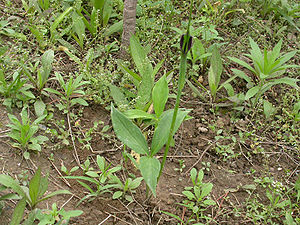Pine trees
| Pine trees | ||||||||||||
|---|---|---|---|---|---|---|---|---|---|---|---|---|

Threefold pine tree ( Pinellia ternata ) |
||||||||||||
| Systematics | ||||||||||||
|
||||||||||||
| Scientific name | ||||||||||||
| Pinellia | ||||||||||||
| Ten. |
The Pinellia ( Pinellia ), also known as Asian mouse plants, are a genus within the family of the arum family (Araceae). The nine or so species are native to China , Korea and Japan .
description

Pinellia species grow as perennial herbaceous plants . Tubers are formed as permanent organs; Brood nodules are also formed in the leaf axils. Two to five leaves stand together in a basal rosette. The leaves are divided into a petiole and a leaf blade. The leaf blade is simple to compound.
Pinellia species are single sexed ( monoecious ). As with most Aroideae , the inflorescence consists of an inflorescence stem, only a bract ( spathe ) and the piston ( spadix ). The inflorescence stem is longer than the petioles. In the piston (spadix) there are male flowers below and female flowers above , which are separated from each other by a membrane. The reduced flowers have no bracts . The male flowers thus contain only two stamens with short stamens. The female flowers contain only one ovary . The berries stay green even when ripe and contain only one seed.
distribution
The genus Pinellia is native to East Asia. Pinellia species are found in China , Korea, and Japan .
Systematics
The genus Pinellia was established in 1839 by Michele Tenore in Atti della Reale Accademia delle Scienze: Sezione della Societa Reale Borbonica , 4, p. 69. The generic name Pinellia honors the Italian Giovanni Vincenzo Pinelli (1535–1601), an Italian scholar in Naples. He owned a large library and his private garden 'Giardina della Montagnole' later became one of the first botanical gardens in Naples.
There are about ten species of Pinellia , eight of them in China:
- Pinellia cordata N.E.Br. : It only occurs in southern China.
- Pinellia fujianensis H.Li : It occurs only in China (Fujian).
- Pinellia hunanensis C.L. Long & XJWu : The species first described in 2013 occurs in Hunan .
- Pinellia integrifolia N.E.Br. : It occurs only in China (Sichuan, Chongqing, Hubei).
- Pinellia pedatisecta Schott ( Syn .: Pinellia wawrae Engl. ): It occurs only in central and southern China.
- Pinellia peltata Pei : It occurs only in southeastern China.
- Pinellia polyphylla S.L.Hu : It is only found in Sichuan Province in China.
- Threefold Pinellia ( Pinellia ternata (Thunb.) Makino , Syn .: Pinellia cochinchinense (Blume) W.Wight , Pinellia tuberifera Ten. ): It is native to China, Taiwan, Korea as well as Japan and the Nansei Islands .
- Pinellia tripartita (flower) Schott : It occurs only in Japan, the Nansei Islands, in southern Korea and Hong Kong.
- Pinellia yaoluopingensis X.H.Guo & XLLiu : It occurs only in China (Anhui, Jiangsu).
use
The subterranean plant parts are used in Chinese medicine; the name of the drug is Rhizoma Pinelliae. They are used in diseases such as coughing with copious amounts of phlegm, nausea, vomiting, gastrointestinal diseases and dizziness.
swell
- Heng Li & Josef Bogner: Pinellia , p. 39 - online with the same text as the printed work , In: Wu Zheng-yi, Peter H. Raven, Deyuan Hong (ed.): Flora of China . Volume 23: Acoraceae through Cyperaceae . Science Press / Missouri Botanical Garden Press, Beijing / St. Louis 2010, ISBN 978-1-930723-99-3 (English). (Sections Description, Distribution and Systematics)
Individual evidence
- ↑ a b Walter Erhardt among others: The great pikeperch. Encyclopedia of Plant Names . Volume 2. Verlag Eugen Ulmer, Stuttgart 2008. ISBN 978-3-8001-5406-7
- ↑ a b Heng Li & Josef Bogner: Pinellia , p. 39 - online with the same text as the printed work , In: Wu Zheng-yi, Peter H. Raven, Deyuan Hong (ed.): Flora of China . Volume 23: Acoraceae through Cyperaceae . Science Press / Missouri Botanical Garden Press, Beijing / St. Louis 2010, ISBN 978-1-930723-99-3 (English).
- ↑ Lotte Burkhardt: Directory of eponymous plant names . Botanic Garden and Botanical Museum Berlin, Free University Berlin Berlin 2016. ISBN 978-3-946292-10-4 , page 791. doi : 10.3372 / epolist2016
- ↑ Pinellia in the Germplasm Resources Information Network (GRIN), USDA , ARS , National Genetic Resources Program. National Germplasm Resources Laboratory, Beltsville, Maryland.
- ↑ a b c d e f g h i j k Rafaël Govaerts (Ed.): Pinellia. In: World Checklist of Selected Plant Families (WCSP) - The Board of Trustees of the Royal Botanic Gardens, Kew . Retrieved June 14, 2018.